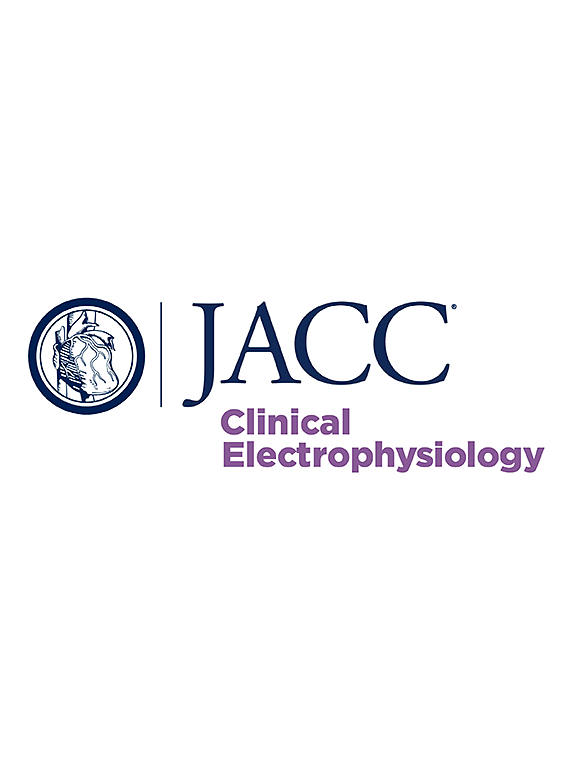心血管消融术治疗功能性心动过缓和血管迷走神经性晕厥的结果来自美国多中心cna登记。
IF 7.7
1区 医学
Q1 CARDIAC & CARDIOVASCULAR SYSTEMS
引用次数: 0
摘要
背景:对于症状性功能性心动过缓和衰弱性血管迷走神经性晕厥(VVS)患者,心神经消融(CNA)有望成为永久性心脏起搏和药物治疗的可行替代方案。支持CNA潜在治疗作用的证据受到来自主要单中心报告的相对较小的样本量的限制。目的:通过美国首次大型多中心登记报告CNA的可行性、安全性和临床疗效。方法:来自美国15个地点的多中心登记,收集2018-2024年期间,因复发性VVS或症状性功能性心动过缓[窦性心动过缓(SB)或房室传导阻滞(AVB)]难以接受药物治疗和行为改变而接受CNA治疗的连续患者的数据。结果:205例患者接受了210例CNA手术,平均年龄为47±17岁,49%为女性,基线LVEF为60±5%。CNA最常见的适应症是VVS晕厥(62%),其次是SB (32%), AVB(3%),或SB和AVB兼有(2%)。所有病例均采用解剖入路,以典型的神经节丛(GP)为靶点,其中47%的手术采用高频刺激。针对GPs的心内膜消融在两个心房中占77%,射频应用时间为697±515秒。在消融过程中分别有52%和73%的病例出现迷走神经和交感神经反应。消融后立即的平均心率增加为20±15 bpm。4.7%的手术出现并发症:2例呼吸衰竭需要BiPAP, 1例右侧膈肌麻痹,4例窦房结功能障碍,主要不良事件发生率为1.4%(2例心包积血,1例死亡)。在平均14±11个月的随访中,78%的晕厥患者没有复发,发作次数从中位数7(4-15)次减少到中位数0(0-0)次。97%的患者没有植入心脏起搏器。结论:在迄今为止最大的多中心CNA试验中,基线心率加快,晕厥负担显著减轻,主要手术并发症发生率可接受。这些观察性数据为未来的随机试验铺平了道路,以发展CNA适应症,而不是用于治疗功能性心动过缓和反射性晕厥。本文章由计算机程序翻译,如有差异,请以英文原文为准。
Cardioneural Ablation for Functional Bradycardia and Vasovagal Syncope
Background
Cardioneural ablation (CNA) shows promise as a viable alternative to permanent cardiac pacing and pharmacotherapy for patients with symptomatic functional bradycardia and debilitating vasovagal syncope (VVS). The evidence supporting a potential therapeutic role for CNA is limited by relatively small sample sizes from predominantly single-center reports.
Objectives
This study sought to report the feasibility, safety, and clinical efficacy of CNA from a large, first-ever multicenter US registry.
Methods
A multicenter registry from 15 US sites was established by collecting data from consecutive patients undergoing CNA for recurrent VVS or symptomatic functional bradycardia (sinus bradycardia [SB] or atrioventricular block [AVB]) refractory to medical therapy and behavioral modification (2018-2024).
Results
A total of 205 patients who underwent 210 CNA procedures were included. The mean age was 47 ± 17 years, 49% were female, and baseline left ventricular ejection fraction was 60% ± 5%. The most common indication for CNA was syncope in 66.3% (VVS 61.5%, syncope related to AVB 4.9%), followed by SB in 31.2%, AVB in 1.5%, or both SB and AVB in 0.9%. An anatomical approach to target typical ganglionated plexus locations was implemented in all cases, with high-frequency stimulation in 47% of procedures. Endocardial ablation targeting ganglionated plexuses was performed in both atria in 77%, with 697 ± 515 seconds of radiofrequency application. Vagal and sympathetic responses during ablation were observed in 52% and 73% of cases, respectively. The mean increase in heart rate immediately after ablation was 20 ± 15 beats/min. Complications were observed in 4.7% of procedures: 2 respiratory failures requiring bilevel positive airway pressure, 1 right diaphragmatic paralysis, and 4 sinus node dysfunction, with a major adverse event rate of 1.4% (2 hemopericardium, 1 death). At a mean follow-up of 14 ± 11 months, 78% of patients with syncope remained free from recurrence, with a reduction in episodes from a median of 7 (4-15) episodes to a median of 0 (0-0) episodes. Overall, 97% of the cohort remained free from pacemaker implantation.
Conclusions
In the largest multicenter CNA experience to date, acceleration of baseline heart rate and a significant reduction in syncope burden were achieved with an acceptable rate of major procedural complications. These observational data pave the way for future randomized trials to evolve CNA indications beyond compassionate usage for managing functional bradycardia and reflex syncope.
求助全文
通过发布文献求助,成功后即可免费获取论文全文。
去求助
来源期刊

JACC. Clinical electrophysiology
CARDIAC & CARDIOVASCULAR SYSTEMS-
CiteScore
10.30
自引率
5.70%
发文量
250
期刊介绍:
JACC: Clinical Electrophysiology is one of a family of specialist journals launched by the renowned Journal of the American College of Cardiology (JACC). It encompasses all aspects of the epidemiology, pathogenesis, diagnosis and treatment of cardiac arrhythmias. Submissions of original research and state-of-the-art reviews from cardiology, cardiovascular surgery, neurology, outcomes research, and related fields are encouraged. Experimental and preclinical work that directly relates to diagnostic or therapeutic interventions are also encouraged. In general, case reports will not be considered for publication.
 求助内容:
求助内容: 应助结果提醒方式:
应助结果提醒方式:


